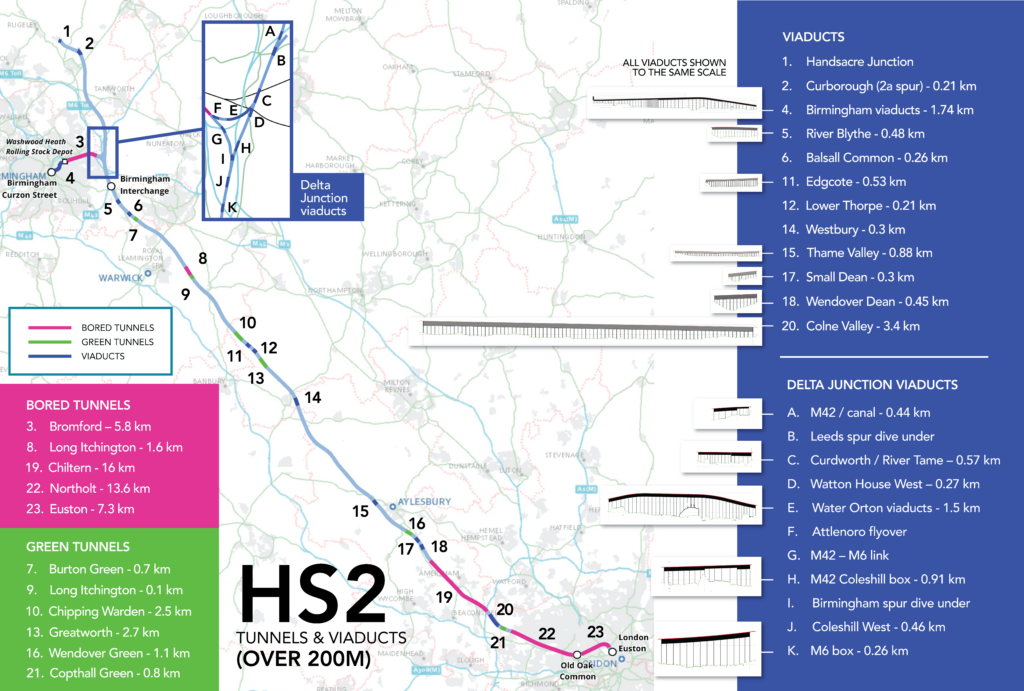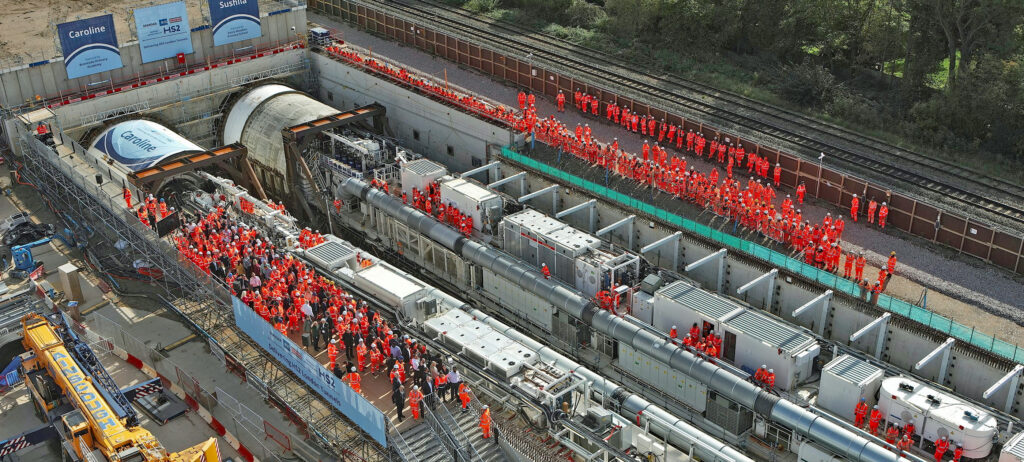The forecast date for initial HS2 services between Old Oak Common and Birmingham Curzon Street is between 2029 and 2033. Although this may seem some time away, this year HS2 hits peak construction with work well underway and a workforce of 30,000 at 350 active sites.
This work is being delivered by four main works contracts for which stage 1 is design and development and stage 2 is delivery and execution. In 2017, stage 1 of these contracts was awarded as shown below.
In April 2020, a ‘notice to proceed’ to stage 2 was issued to the companies concerned. This enabled construction work to formally start in September 2020. After almost three-and-a-half years, work has begun on two thirds of HS2’s viaducts, over half of its bridges, and a third of the tunnelling has been completed.

With its civil engineering now well advanced, this year will be HS2’s peak construction year. 2024 will also see the award of contracts for the installation of track, signalling, and overhead line work. Although the HS2 route is now one long building site, it will not be that long before it starts to look like a railway. Yet before then there is still much complex civil engineering work to be done. HS2 has been described as a ‘project of megaprojects’.
Readers are invited to judge the truth of this statement for themselves as Rail Engineer provides an overview of HS2’s tunnels and viaducts.
The route
Without doubt, the most complex and expensive part of HS2 is from Euston to the Chiltern tunnel’s northern portal. Of this 47.2 route km, only 6.1km is on open ground as 37.7km is tunnels and 3.4km is the Colne Valley viaduct which will be Britain’s longest railway bridge.
The 109.5km from the Chiltern tunnel to the HS2’s Interchange station in Solihull is primarily through open countryside. This stretch has 22 viaducts of which five are over 300 metres long. They are Wendover Dean (450 metres); Small Dean (315 metres); Thame Valley (880 metres); Westbury (320 metres); and Edgcote (515 metres). To preserve the ancient woodland above it, a 1.7km tunnel has been bored under Long Itchington Wood.
This part of the route also has five cut and cover ‘Green’ tunnels totalling 7.1km. It also has two railway crossings. A new bridge carries the new East West rail line over HS2 at Calvert (80.1km). Another bridge takes HS2 under the Coventry to Leamington Line at Kenilworth (142.2km).
HS2’s Delta Junction is immediately north of its Interchange station in Solihull. The Delta Junction has grade separation at its three junctions and is made up of embankments, cuttings, and a total of 13 viaducts taking high speed tracks over motorways, local roads, existing rail lines, rivers, and floodplains. The viaducts include six precast segmental viaducts, four composite viaducts, and three low viaducts.
Immediately after the Delta Junction, the 11.3km Birmingham spur starts with the 5.8km long Bromford tunnel which emerges at the eastern end of the Washwood Heath train maintenance depot. The spur is on a series of viaducts 1.7km long, immediately before it terminates at Curzon Street station 175.68 km from Euston.

Going north, the planned flyover over the Leeds spur (166.4 km) is 2km beyond the Delta Junction. Whether this will remain as passive provision is not known. Beyond that, HS2 again crosses the M42 on a box structure. From there, HS2 generally runs through open countryside to a point north of the city where a flyover was planned for HS2 phase 2a (185.8km) which now may well not be built. HS2 phase 1 ends at Handsacre junction 192.77km from Euston.
As at the start of 2024, 45km of tunnels have been dug and work is underway on two thirds of the project’s viaducts and over half of its bridges. The project is currently an unsightly building site passing though some areas of natural beauty. Yet by 2025, most of its civil engineering will be completed and a start will be made installing track and other railway systems.
The bare earth of the project’s excavations will then start to be covered by grass and vegetation. HS2 will then start to look like a railway and blend into the countryside as all railways do.
Lead image credit: HS2


